Overview
Following in the footsteps of her teachers, photographers Bernd and Hilla Becher, who also taught such iconic photographers as Andreas Gursky, Thomas Ruff, and Thomas Struth, Höfer takes pictures that immortalize these architectural spaces. Her majestic large-scale photographs capture with absolute symmetry the elegance and the design of these spaces, many of which encapsulate the psychology attributed to empty public and institutional spaces. Meticulously composed, her images are symmetrically positioned either in the center of these rooms or alternatively along a diagonal to best reveal the internal architectural structure of the chosen space. Preferring spaces that contain an element of architectural or institutional history such as libraries or in our example palaces, Höfer explores through her photographs the built environment and how it affects the human experience—what spaces do for us and to us. Despite the symmetry and accuracy of these shots, there is an overriding sense of emptiness or loss, often as the use or significance of these spaces has changed over time.
